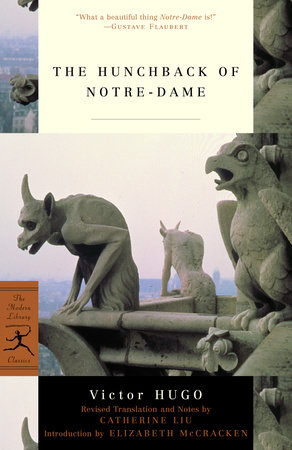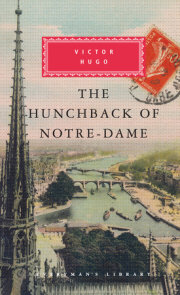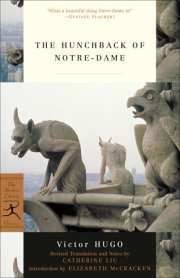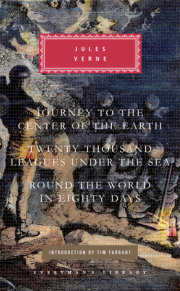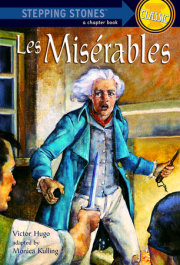CHAPTER I
The Great Hall of the Palace of Justice Three hundred and forty-eight years, six months, and nineteen days ago, the good people of Paris awoke to the sound of all the bells pealing in the three districts of the Cité, the Université, and the Ville. The sixth of January, 1482, was, however, a day that history does not remember. There was nothing worthy of note in the event that set in motion early in the morning both the bells and the citizens of Paris. It was neither an assault of the Picards nor one of the Burgundians, nor a procession bearing the shrine of some saint, nor a student revolt in the vineyard of Laas, nor an entry of “our most feared Lord, Monsieur the King,” nor even a lovely hanging of thieves of either sex before the Palace of Justice of Paris. It was also not the arrival of some bedecked and befeathered ambassador, which was a frequent sight in the fifteenth century. It was barely two days since the last cavalcade of this kind had been seen, as the Flemish ambassadors commissioned to conclude a marriage between the Dauphin and Margaret of Flanders had entered Paris, to the great annoyance of the Cardinal de Bourbon, who, in order to please the King, had been obliged to receive the entire rustic crew of Flemish burgomasters with a gracious smile, and to entertain them at his Hôtel de Bourbon with “very elaborate morality plays, mummery, and farce,” while pouring rain drenched the magnificent tapestry at his door.
On the sixth of January, what moved the entire population of Paris was the double solemnity, as Jehan de Troyes describes it, united from time immemorial, of the Epiphany and the Festival of Fools. On that day there were to be fireworks on the Place de Grève, a may tree planted at the chapel of Braque, and a play performed at the Palace of Justice. Proclamation had been made to this effect on the preceding day, to the sound of trumpets in the public squares, by the Provost’s officers in fair coats of purple camlet, with large white crosses on the breast.
That morning, therefore, all the houses and shops remained shut, and crowds of citizens of both sexes could be seen wending their way toward one of the three places mentioned above. Each person had made a choice, for fireworks, may tree, or play. It must be observed, however, to the credit of the taste of Parisian riffraff, that the greater part of the crowd was proceeding toward the fireworks, which were quite appropriate to the season, or the play, which was to be represented in the great hall of the palace, which was well covered and protected, and that the curious agreed to let the poor leafless may tree shiver all alone beneath a January sky in the cemetery of the chapel of Braque.
All the avenues leading to the Palace of Justice were particularly crowded, because it was known that the Flemish ambassadors, who had arrived two days before, planned to attend the performance of the play, and the election of the Pope of Fools, which was also to take place in the great hall.
On that day, it was no easy matter to get into this great hall, though it was then reputed to be the largest covered space in the world. (It is true that Sauval had not yet measured the great hall of the Château of Montargis.) To the spectators at the windows, the palace yard crowded with people looked like a sea, into which five or six streets, like the mouths of so many rivers, disgorged their living streams. The waves of this sea, incessantly swelled by new arrivals, broke against the corners of the houses, projecting here and there like promontories into the irregular basin on the square. In the center of the lofty Gothic facade of the palace, the crowds moved relentlessly up and down the grand staircase in a double current interrupted by the central landing, and they poured incessantly into the square like a cascade into a lake. The cries, the laughter, and the trampling of thousands of feet produced a great din and clamor. From time to time this clamor and noise were redoubled; the current that propelled the crowd toward the grand staircase turned back, grew agitated, and whirled around. Sometimes it was a push made by an archer, or the horse of one of the Provost’s sergeants kicking and plunging to restore order—an admirable tradition, which the Provosty bequeathed to the constablery, the constablery to the maréchaussée, and the maréchaussée to the present gendarmerie of Paris.
At doors, windows, garret windows, on the rooftops of the houses, swarmed thousands of calm and honest bourgeois faces gazing at the palace and at the crowd, and desiring nothing more; for most of the good people of Paris are quite content with the sight of the spectators; a blank wall, behind which something or other is going forward, is to us an object of great curiosity.
If we could, mortals living in this year of 1830, imagine ourselves mixed up with those fifteenth-century Parisians, and if we could enter with them, shoved, elbowed, hustled, that immense hall of the palace so tightly packed, on the sixth of January, 1482, the sight would not be lacking in interest or in charm; and all that we should see around us would be so ancient as to appear absolutely new. If the reader pleases, we will endeavor to retrace in imagination the impressions that one would have experienced with us on crossing the threshold of the great hall, in the midst of this motley crowd, coated, gowned, or clothed in the paraphernalia of office.
In the first place, how one’s ears are stunned by the noise! How one’s eyes are dazzled! Overhead is a double roof of pointed arches, with carved wainscoting, painted sky blue, and studded with golden fleurs-de-lis; underfoot, a pavement of alternate squares of black and white marble. A few paces from us stands an enormous pillar, then another, and another; in all, seven pillars, intersecting the hall longitudinally, and supporting the thrust of the double-vaulted roof. Around the first four pillars are shops, glittering with glass and jewelery; and around the other three, oak benches worn and polished by the hosiery of the plaintiffs and the gowns of the attorneys. Along the lofty walls, between the doors, between the windows, between the pillars, is ranged the interminable series of all the kings of France ever since Pharamond: the indolent kings with pendant arms and downcast eyes; the valiant and warlike kings with heads and hands boldly raised toward heaven. The tall, pointed ogival windows are glazed with panes of a thousand hues; for exits there are rich doors, finely carved. The whole thing—ceiling, pillars, walls, wainscot, doors, statues—is covered from top to bottom with beautiful blue and gold paint, which was already somewhat faded at the time we are looking at it. It was almost entirely buried in dust and cobwebs in the year of grace 1549, when du Breul still admired it by tradition.
Now imagine that immense oblong hall, illuminated by the pale light of a January day, invaded by a motley and noisy crowd, pouring in along the walls and circling the pillars, and you will have a faint idea of the general whole of the picture, the curious details of which we shall endeavor to sketch in more precisely.
It is certain that if Ravaillac had not assassinated Henry IV there would have been no documents of his trial deposited in the Rolls Office of the Palace of Justice, and no accomplices interested in the destruction of those documents; consequently no obligatory fire, for lack of better means, to burn the Rolls Office in order to burn the documents, and to burn the Palace of Justice in order to burn the Rolls Office; therefore, there would have been no fire in 1618. The old palace would still be standing with its old great hall; and I might then say to the reader, “Go, look at it,” and thus we should both be spared trouble, myself the trouble of writing, and the reader that of perusing, a banal description. This demonstrates the novel truth—that great events have incalculable consequences.
It is, indeed, possible that Ravaillac had no accomplices and that even if he did, these accomplices had no hand in the fire of 1618. There are two other plausible explanations: first, the great “star of fire, a foot broad, and a foot and a half high,” which fell, as everybody knows, from the sky onto the Palace on the seventh of March, after midnight; second, this stanza of Théophile.
Certes, ce fut un triste jeu,
Quand à Paris dame Justice,
Pour avoir mangé trop d’épice,
Se mit tout le palais en feu.Whatever one may think of this threefold explanation, political, physical, and lyrical, of the burning of the Palace of Justice in 1618, the fact of which we may unfortunately be certain is that there was a fire. Owing to this catastrophe, and, above all, to the successive restorations that have swept away what it spared, very little is now left of this elder Palace of the Louvre, already so ancient in the time of Philip the Fair that one had to search there for the traces of the magnificent buildings erected by King Robert and described by Hegaldus. Almost everything has vanished. What has become of the Chancery Chamber, where Saint Louis consummated his marriage? The garden where, reclining on carpets with Joinville, he administered justice, dressed in a camlet coat, an overcoat of sleeveless woolsey and, over all of this, a mantle of black serge? Where is the chamber of the Emperor Sigismond? That of Charles IV? Or that of Jean sans Terre? Where is the flight of steps from which Charles VI announced his edict of amnesty? The slab upon which Marcel murdered, in the presence of the Dauphin, Robert de Clermont and the Maréchal de Champagne? And the wicket where the Anti-Pope Benedict’s bulls were torn into pieces, and from which those who had brought them were seized, coped, and mitered in derision, and carried in procession through all Paris? And the great hall, with its gilding, its azure, its pointed arches, its statues, its pillars, its immense vaulted ceiling, broken up by and covered with carvings? And the gilded chamber? And the stone lion at the gate, kneeling, with head lowered and tail between his legs, like the lions of King Solomon’s throne, in the reverential attitude that befits strength in the presence of justice? And the beautiful doors? And the stained glass windows? And the wrought iron that discouraged Biscornette? And du Hancy’s delicate woodwork? What has time, what have men, wrought with these wonders? What has been given to us, in exchange for all this—for the history of the Gauls, for all this Gothic art? For the heavy, low arches of Monsieur de Brosse, for the clumsy architecture of the main entrance of Saint-Gervais? So much for art! And as for history, we have the voluble memory of great pillar, which still reverberates with the gossip of the Patrus.
Copyright © 2002 by Victor Hugo. All rights reserved. No part of this excerpt may be reproduced or reprinted without permission in writing from the publisher.

